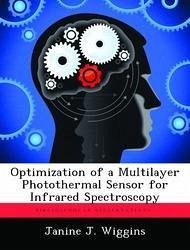Nicht lieferbar

Optimization of a Multilayer Photothermal Sensor for Infrared Spectroscopy
Versandkostenfrei!
Nicht lieferbar
Mathematical modeling and atomic force microscopy were used to optimize a multi-layer reed sensor for use in a new infrared detection system. The reed sensor is designed to deflect in response to temperature variations. In this system, a sample absorbs infrared light (modulated at some frequency to reduce noise) and releases heat into the reed. The layers expand differently, causing the reed to deflect. The deflection is influenced by geometric parameters, such as length and thickness of each layer, and also by the frequency of modulation. Deflection is easily measured using an atomic force mi...
Mathematical modeling and atomic force microscopy were used to optimize a multi-layer reed sensor for use in a new infrared detection system. The reed sensor is designed to deflect in response to temperature variations. In this system, a sample absorbs infrared light (modulated at some frequency to reduce noise) and releases heat into the reed. The layers expand differently, causing the reed to deflect. The deflection is influenced by geometric parameters, such as length and thickness of each layer, and also by the frequency of modulation. Deflection is easily measured using an atomic force microscope. This research applied a mathematical model to the reed sensor, explored the effect of varying geometric parameters, and used experimental testing to evaluate the model. Several reeds were tested to validate the model, which predicted sensitivity, maximum deflection, resonance frequency, and signal to noise ratio. Varying concentrations of absorbing chemical were deposited in the reed, to cause a change in deflection. A cantilever reed having three layers was modeled mathematically using a recently developed thermal model and a mechanical model based on two-layer theory. This work has been selected by scholars as being culturally important, and is part of the knowledge base of civilization as we know it. This work was reproduced from the original artifact, and remains as true to the original work as possible. Therefore, you will see the original copyright references, library stamps (as most of these works have been housed in our most important libraries around the world), and other notations in the work. This work is in the public domain in the United States of America, and possibly other nations. Within the United States, you may freely copy and distribute this work, as no entity (individual or corporate) has a copyright on the body of the work. As a reproduction of a historical artifact, this work may contain missing or blurred pages, poor pictures, errant marks, etc. Scholars believe, and we concur, that this work is important enough to be preserved, reproduced, and made generally available to the public. We appreciate your support of the preservation process, and thank you for being an important part of keeping this knowledge alive and relevant.






